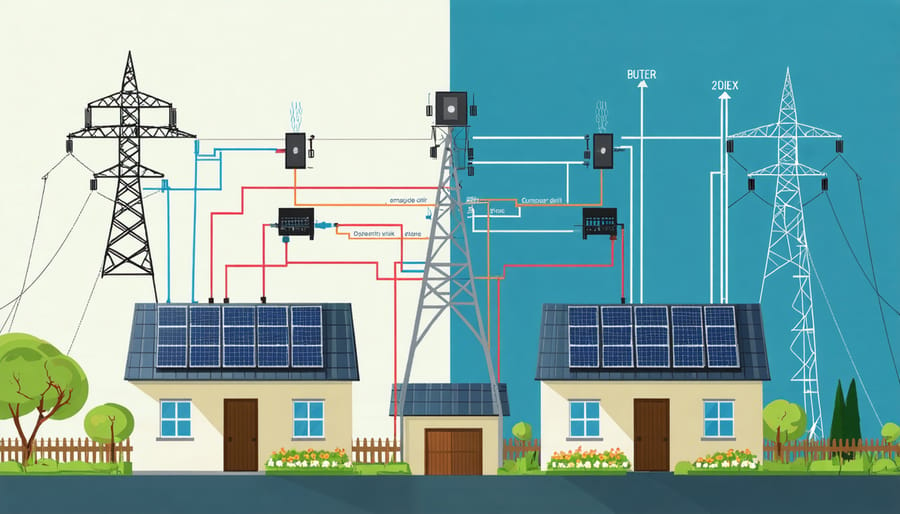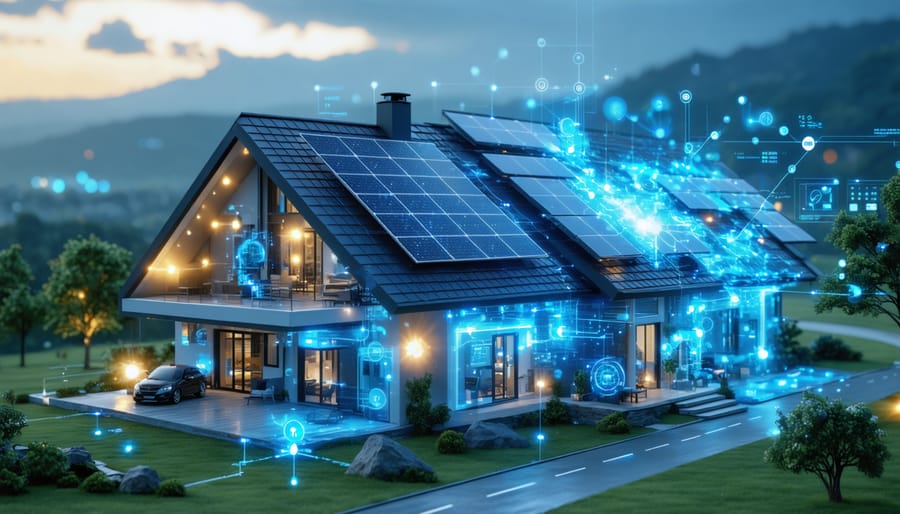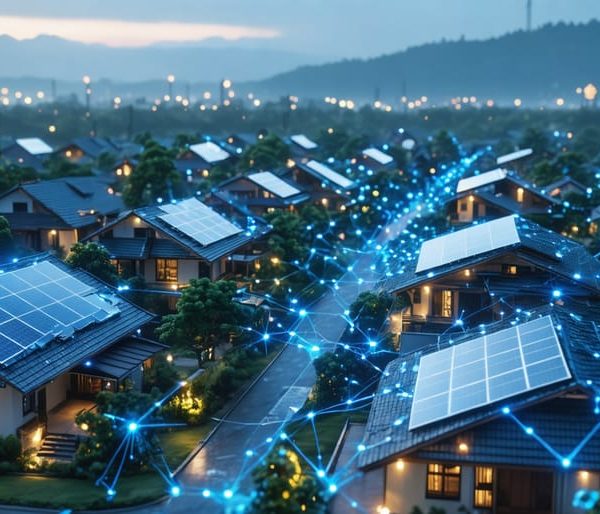Smart Grid Solar Integration Made Simple: Power Your Home Smarter
Imagine powering your home with clean, renewable energy while staying connected to a sophisticated grid that optimizes your power usage automatically. That’s the promise of renewable integration in smart grids – a game-changing approach that’s revolutionizing how we generate, distribute, and consume electricity.
Smart grids are transforming traditional one-way power systems into dynamic, two-way networks where homeowners can both consume and produce energy. By connecting your solar panels, wind turbines, or other renewable sources to this intelligent infrastructure, you’re not just reducing your carbon footprint – you’re becoming part of a more resilient, efficient energy ecosystem.
The benefits are compelling: lower utility bills, increased energy independence, and the ability to sell excess power back to the grid. Plus, smart grid technology automatically adjusts your home’s energy consumption based on real-time data, ensuring optimal use of your renewable resources. Whether you’re considering your first solar installation or looking to upgrade your existing system, integrating with the smart grid is becoming less of a luxury and more of a necessity for the modern, energy-conscious homeowner.
This technology isn’t just about individual benefits – it’s about creating a more sustainable future where clean energy flows seamlessly between homes, businesses, and utilities, powered by intelligent systems that maximize efficiency while minimizing environmental impact.

How Smart Grids Transform Your Solar Investment
Real-Time Energy Management
Smart grids transform how we manage solar power by providing real-time monitoring and control capabilities. Think of it as having a smart thermostat for your entire home’s energy system, but much more sophisticated. The system continuously tracks your solar production, household consumption, and grid conditions, making split-second decisions to optimize your energy use.
When your solar panels are producing excess power during sunny afternoons, the smart grid can automatically direct that energy to run your dishwasher or charge your electric vehicle. If clouds roll in, it smoothly transitions to grid power without any interruption to your home’s operations. This intelligent management ensures you’re making the most of your solar investment.
For homeowners, this means seeing exactly how much energy you’re producing and using through user-friendly apps. You can schedule energy-intensive activities for peak solar production times and receive alerts when your system needs attention. The smart grid even helps you sell excess power back to utility companies at the most profitable times, maximizing your return on investment while contributing to a more sustainable energy future.
Two-Way Power Flow Benefits
One of the most exciting features of smart grid integration is two-way power flow, which allows homeowners to become active participants in the energy marketplace. When your solar panels generate more electricity than you need, instead of letting that energy go to waste, you can sell it back to the utility company. This process, known as net metering, helps offset your electricity bills and can even earn you energy credits.
Think of it like having a savings account for electricity. During sunny days, your excess power is “deposited” into the grid, and you can “withdraw” it later when your panels aren’t producing enough power, such as during nighttime or cloudy days. Many utility companies offer competitive rates for this excess power, making your renewable energy investment even more financially rewarding.
The benefits extend beyond monetary savings. By feeding excess power back to the grid, you’re helping your community access clean energy and reducing the overall strain on traditional power plants during peak demand periods.
Essential Components for Solar Smart Grid Connection
Smart Meters and Monitoring Systems
Smart meters and monitoring systems serve as the eyes and ears of your renewable energy setup, providing real-time data about energy production, consumption, and grid interaction. These devices help you make informed decisions about your energy usage while ensuring optimal performance of your renewable systems.
Modern smart meters can track both incoming power from the grid and outgoing power from your solar panels or other renewable sources. They display this information through user-friendly interfaces, often accessible via smartphone apps, making it easy to monitor your energy patterns from anywhere.
Key monitoring components typically include:
– Advanced metering infrastructure (AMI) that provides two-way communication between your home and utility provider
– Energy management systems that track consumption patterns
– Power quality sensors that ensure stable electricity supply
– Weather monitoring stations that help predict renewable energy generation
These systems also feature automatic alerts that notify you about potential issues, helping prevent system failures before they occur. For example, if your solar panels’ output suddenly drops, you’ll receive an alert to check for problems like dust accumulation or shade interference.
The data collected helps optimize your renewable energy usage by suggesting the best times to run high-consumption appliances based on peak generation periods. This intelligence transforms your home into an energy-efficient ecosystem that maximizes renewable resource utilization while minimizing grid dependency.
Many utility companies now offer free smart meter installations as part of their grid modernization efforts, making it easier than ever to start monitoring your energy use.

Grid-Tie Inverters
Grid-tie inverters are essential components that enable renewable energy systems to seamlessly connect with the power grid. These smart devices convert the DC power generated by solar panels into grid-compatible AC power, making grid-tie systems both efficient and reliable.
Modern grid-tie inverters come equipped with advanced features that enhance system performance and safety. They automatically monitor grid conditions and shut down if the grid goes offline, preventing dangerous backfeeding. Many models include built-in monitoring capabilities that let you track energy production through smartphone apps or web portals.
When selecting a grid-tie inverter, consider these key features:
– Anti-islanding protection for safety
– Maximum power point tracking (MPPT) for optimal energy harvest
– Power quality monitoring and adjustment
– Communication capabilities for smart grid integration
– Weather-resistant housing for outdoor installation
Today’s inverters achieve impressive efficiency rates of 95-98%, meaning nearly all the power your solar panels generate makes it to the grid. They’re designed to work seamlessly with your home’s existing electrical system, requiring minimal maintenance while providing years of reliable service.
For homeowners, this means you can generate clean energy and feed excess power back to the grid, potentially earning credits on your utility bill through net metering programs.
Setting Up Your Smart Grid Solar System
Planning Your Integration
Successfully integrating renewable energy into your smart grid system starts with thorough planning. Begin by assessing your current energy consumption patterns – track your usage over several months to understand your peak demand times and baseline needs. This information will help you determine the right size and type of renewable energy system for your property.
Next, evaluate your property’s potential for renewable energy generation. For solar installations, consider factors like roof orientation, shading from nearby structures or trees, and available surface area. If you’re interested in wind energy, assess local wind patterns and zoning regulations that might affect turbine installation.
Create a detailed budget that includes not just installation costs, but also potential incentives and rebates. Many states and utilities offer financial assistance for renewable energy projects, which can significantly reduce your initial investment. Don’t forget to factor in long-term maintenance costs and potential energy storage solutions.
Consult with certified renewable energy professionals who understand smart grid integration. They can help you choose compatible equipment and ensure your system meets local codes and utility requirements. It’s crucial to discuss interconnection requirements with your utility company early in the planning process.
Consider starting with a smaller system that you can expand later. This approach allows you to learn from experience and adjust your system based on actual usage patterns. Many modern renewable energy systems are modular, making future expansions straightforward.
Finally, develop a timeline for implementation that accounts for permitting processes, installation schedules, and any necessary upgrades to your existing electrical system. Remember that proper planning now will lead to smoother integration and better long-term results.
Working with Utility Companies
Working with utility companies is a crucial step in integrating renewable energy into the smart grid. Most utilities have specific requirements and processes that homeowners and property managers must follow to ensure a smooth connection.
Start by contacting your local utility company early in your renewable energy project planning. They can provide valuable information about interconnection requirements, necessary permits, and any incentive programs available in your area. Many utilities now have dedicated renewable energy departments to help customers navigate the process.
You’ll need to submit an interconnection application, which typically includes details about your system’s size, equipment specifications, and installation plans. Your utility will review this application to ensure your system meets their safety and technical standards. They’ll also determine if any grid upgrades are needed to accommodate your renewable energy system.
Be prepared to install a bi-directional meter, which measures both the energy you draw from the grid and the excess energy your system sends back. Most utilities require this for accurate billing and monitoring purposes. They may also require additional safety equipment, such as automatic shut-off switches.
Keep in mind that response times and requirements can vary significantly between utility companies. Some may process applications within weeks, while others might take several months. It’s important to factor this timeline into your project planning.
Many utilities now offer online portals where you can track your application status, submit documents, and communicate with their renewable energy team. Take advantage of these tools to streamline the process and stay informed about your project’s progress.
Remember to maintain open communication with your utility throughout the installation process. This helps prevent delays and ensures all requirements are met before system activation.
Maximizing Your Smart Grid Benefits
Energy Usage Optimization
Effective energy usage optimization is key to maximizing the benefits of renewable integration in smart grids. Start by conducting an energy audit to identify peak usage times and major power consumers in your property. Install smart meters and energy monitoring devices to track real-time consumption patterns and adjust accordingly.
Set up automated controls for large appliances to run during off-peak hours when electricity rates are lower. For example, schedule your dishwasher, washing machine, and electric vehicle charging for overnight hours. Consider installing programmable thermostats that adjust temperature settings based on occupancy and time of day.
Take advantage of smart grid features like demand response programs, which offer incentives for reducing consumption during high-demand periods. Use smart power strips to eliminate phantom loads from electronics in standby mode. LED lighting with motion sensors can significantly reduce unnecessary energy use in less frequently occupied areas.
Create zones in your property to manage heating and cooling more efficiently. Utilize natural lighting and passive solar heating where possible. Regular maintenance of HVAC systems and other major appliances ensures they operate at peak efficiency. Remember to educate all occupants about energy-saving practices and make them active participants in optimization efforts.
By implementing these strategies, you can reduce energy costs while supporting grid stability and environmental sustainability.

Maintenance and Monitoring
Regular maintenance of your renewable energy system ensures optimal performance and longevity of your smart grid integration. Start with weekly visual inspections of solar panels, checking for dust, debris, or damage. Clean panels every three months using soft brushes and approved cleaning solutions to maintain maximum efficiency.
Monitor your system’s performance through the smart grid interface daily. Most modern systems come with user-friendly apps that display real-time energy production, consumption, and grid interaction. Pay attention to unusual patterns or sudden drops in performance, as these could indicate potential issues.
Keep detailed records of maintenance activities and system performance. This data helps identify trends and potential problems before they become serious. Schedule professional inspections annually to check electrical connections, inverter performance, and overall system health.
For battery storage systems, check the charge levels and cycling patterns monthly. Ensure proper ventilation around battery units and look for signs of corrosion or damage. Update your system’s software whenever new versions become available to maintain security and efficiency.
Don’t forget to test your backup systems quarterly. This includes checking emergency power switches and ensuring your system properly disconnects from the grid during outages. If you notice any issues or significant performance changes, contact your system provider or a certified technician immediately.
Remember, a well-maintained renewable energy system not only performs better but also provides greater returns on your investment through increased efficiency and longer equipment life.
The integration of renewable energy into smart grids represents a crucial step toward a more sustainable and efficient energy future. Throughout this guide, we’ve explored how smart grid technology transforms the way we generate, distribute, and consume electricity. From solar panels to wind turbines, these renewable sources work seamlessly with intelligent grid systems to provide cleaner, more reliable power while reducing energy costs.
As we’ve seen, the benefits of smart grid integration extend beyond environmental impact. Property owners enjoy reduced utility bills, increased energy independence, and the satisfaction of contributing to a greener future. The ability to monitor and optimize energy usage in real-time, combined with automated load management, makes smart grids an invaluable tool for both residential and commercial properties.
The technology continues to evolve, making renewable integration more accessible and cost-effective than ever before. With user-friendly monitoring systems and increasingly efficient storage solutions, the barriers to adoption are lower than ever. Whether you’re a homeowner looking to install your first solar system or a property manager seeking to optimize your building’s energy performance, the time to embrace smart grid technology is now.
By taking the step toward renewable integration in smart grids, you’re not just investing in your property – you’re participating in the creation of a more sustainable energy infrastructure for future generations. The path to cleaner, smarter energy begins with individual action, and the tools and knowledge are readily available to help you succeed.











